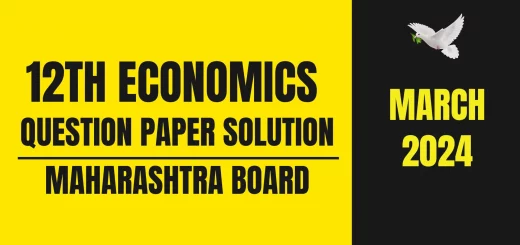11th Economics Chapter 4 Exercise Answers (The Economy of Maharashtra) Maharashtra Board – Free Solution
Table of Contents
11th Economics Chapter 4 Exercise

Chapter 4 – The Economy of Maharashtra
Q. 1. Give economic terms
1) Investments done by foreign companies in our country. – Foreign Direct Investment (FDI)
2) Programme for development of small, medium, and micro industries. – Maharashtra State Industrial Cluster Development Programme (MSICDP)
3) Basic requirement for facilitating production and distribution of goods and services for economic development. – Economic Infrastructure
4) Movement that promotes values of self-help democracy and equality. – Co-operative Movement
Q. 2. Find the odd word out
1) Agricultural Indebtedness, dry farming, lack of capital, engineering
2) Tourism, Banking, Automobile Production, Insurance
3) Pune, Hyderabad, Nasik, Nagpur
4) MTDC, MAITRI, SEZ, MIDC
5) Primary education, Hospitality, Higher education, Skill-based education.
Q. 3. Identify and explain the concepts from the given illustrations
1) To facilitate research in robotic technology, Japan has invested Rs.1000 crores in India.
Concept: Foreign Direct Investment (FDI)
Explanation: A foreign direct investment (FDI) is a purchase of an interest in a company by a company or an investor located outside its borders.
2) Prajakta and her family visited the beaches during her eight-day Diwali vacation.
Concept: Tourism
Explanation: Tourism is the act, and process of spending time away from home in pursuit of recreation, relaxation, and pleasure, while making use of the commercial provision of services.
3) Pravin from Latur works as a technician in the films division at Mumbai city.
Concept: Entertainment Industry
Explanation: The entertainment industry is part of the tertiary sector of the economy and includes many sub-industries devoted to entertainment.
4) Rani Gond from Chandrapur works as a hostess with the Mumbai-Goa cruise ship.
Concept: Hospitality
Explanation: Hospitality is a much broader industry than other industries. It has grown manifold in Maharashtra due to flourishing tourism. One of the most defining aspects of this industry is that it focuses on customer satisfaction.
Solution of other subjects
Solution of all Chapters of Economics
1 – 2– 3 – 4 – 5 – 6 – 7 – 8 – 9 – 10
Q. 4. Distinguish between
1) Economic Infrastructure and Social Infrastructure
| Points | Economic Infrastructure | Social infrastructure |
| 1) Meaning | It facilitates the production and distribution of goods and services for economic development. | It improves the quality of human life as well as stimulates economic development. |
| 2) Example | Energy, transport, communication, etc are examples of Economic infrastructure. | Health, education, etc are examples of Social infrastructure. |
2) Agriculture sector and Service sector
| Points | Agriculture sector | Service sector |
| 1) Meaning | The Agriculture sectors comprise establishments primarily engaged in growing crops, raising animals, and harvesting fish, etc. | The Service sector of industry involves the provision of services to other businesses as well as final consumers. |
| 2) Example | Farming, fishing, mining etc | Transport, communication, tourism, etc |
3) Tourism and Hospitality
| Points | Tourism | Hospitality |
| 1) Meaning | Tourism refers to the business of providing and arranging holidays and services to the people who are visiting a place. | Hospitality refers to the relationship between a guest and host, wherein the host receives the guest with goodwill. |
| 2) Concept | Tourism is a narrow concept, it is included in hospitality. | Hospitality is a broader concept. |
4) Education and Health services
| Points | Education | Health services |
| 1) Meaning | Education is considered as one of the basic human needs. It forms the backbone of the socio-economic development of any country. | Health services refer to medical professionals, organizations, and ancillary health care workers who provide medical care to those in need. |
| 2) Levels | There are four levels of education in our country. 1) Primary 2) Secondary 3) Higher Secondary 4) Higher education | The Government has created a three-tier health infrastructure to provide comprehensive health services. |
Q.5. Answer the following
1) Explain the role of Co-operative movement in Maharashtra.
Answer:
a) Co-operative movement is the greatest contribution given by the state of Maharashtra to the country.
b) Co-operative Movement is an effective instrument in the economic development of rural areas and improving socio-economic conditions of the under-privileged in Maharashtra.
c) The basic nature of co-operative societies is to encourage the values of self-help, democracy, equality
and solidarity.
d) Co-operative movement in Maharashtra was confined mainly to the field of agricultural credit but subsequently extended to other sectors such as agro-processing, agro marketing, sugar co-operatives, fisheries co-operative societies, and co-operative dairy societies.
2) Explain in detail measures taken by the government for agricultural development of Maharashtra.
Answer:
1) Distribution of quality seeds at reasonable rates.
2) Increased number of outlets for fertilizer and pesticide distribution.
3) Development of irrigation facilities.
4) Electrification of agricultural pumps and efforts to provide ‘electricity on demand’.
5) Financial assistance as per requirements.
6) Setting up of Agriculture Produce Marketing Committees (APMC), the establishment of agro-export zones, horticultural training centers, grading, and packing facilities for effective distribution.
7) Creating awareness about agricultural information through the use of mass media for making agriculture a profit-making business.
3) Explain the major problems in the industrial sector of Maharashtra.
Answer:
1) Delays in government procedure
2) Lack of opportunities for skill development.
3) Lack of updated technology.
4) Lack of infrastructural facilities.
5) Lack of motivation for new entrepreneurs.
6) Lack of development programs.
7) Regional imbalance
4) Explain the measures taken to develop social infrastructure in Maharashtra.
Answer:
The measures taken to develop social infrastructure in Maharashtra are as follows:
(A) Education: Education is a significant aspect of Human Resource Development. The state of Maharashtra has implemented various educational schemes to achieve the goal of education at the following four levels:
(1) Primary Education:
a) The state of Maharashtra has implemented the right to education (RTE) for children in the age group 6-14 years to provide free and compulsory education under Sarva Shiksha Abhiyan (SSA).
b) The expenditure of the state government on primary education was ₹19,486 crores during 2016-17.
(2) Secondary and Higher Secondary Education:
a) Rashtriya Madhyamik Shiksha Abhiyan (RMSA) was launched in 2009. The objective of this scheme is to improve access as well as the quality of secondary education.
b) During 2016-17, the state government’s education was ₹16,089 crores.
(3) Higher Education:
a) There are 22 state universities in Maharashtra, of which 4 universities are for agriculture, one for health science courses, one for veterinary science, one for technology, and 15 other for general courses.
b) In addition to these, there are 21 autonomous universities, one Central university 4 private universities, and 5 institutes of national importance in the state.
(B) Health services :
(a) There were 1814 primary health centers and 360 community health centers in the state as on 31st March 2017.
(b) The government of Maharashtra also emphasizes on programs to strengthen the health system in rural and urban areas through the National Rural Health Mission (NRHM) and National Urban Health Mission (NUHM).
(c) These programs include providing health services related to sanitation and hygiene, nutrition, and safe drinking water.
(d) The Government of Maharashtra has created a three-tier health infrastructure to provide health services.
(e) Primary tier includes Primary Health Centres and Community Health Centres.
(f) The Secondary tier includes sub-district hospitals and district hospitals.
(g) The tertiary tier includes well-equipped medical colleges and super specialty hospitals located in major cities.
Solution of other subjects
Solution of all Chapters of Economics
1 – 2– 3 – 4 – 5 – 6 – 7 – 8 – 9 – 10
Q.6. Read the following passage and answer the questions given below
The government of India has launched an ambitious program of ‘Bharatnet’ for rural India by keeping in mind today’s modern era. More than one lakh rural (Grampanchayat) areas have been connected under Bharatnet high-speed broadband scheme. Maharashtra has become the best-performing state. East Uttar Pradesh, Chattisgarh, Rajasthan, and Jharkhand have also been placed among the best performing states in the first phase of the Bharatnet broadband connection scheme.
1) Why did the Government of India launch the Bharatnet project?
Answer: The government of India has launched an ambitious program of ‘Bharatnet’ to provide internet facilities to rural India.
2) How many Gram panchayats have received Internet service?
Answer: More than one lakh Gram panchayats have received internet services.
3) Which states have been placed as the best performing states in the first phase of Bharatnet?
Answer: Maharashtra, East Uttar Pradesh, Chattisgarh, Rajasthan, and Jharkhand have been placed among the best performing states in the first phase of the Bharatnet.
4) ‘Internet has brought the world closer’ – Express your views on it.
Answer: Yes, Communication has become very simple through the internet. Through internet, we can get any information required for business, study, etc. We can get connected with people all over the world.
11th Economics Textbook Solutions
| Chapter Name | Solution Link |
| 1) Basic Concepts in Economics | Solution |
| 2) Money | Solution |
| 3) Partition Values | Solution |
| 4) The Economy of Maharashtra | Solution |
| 5) Rural Development in India | Solution |
| 6) Population in India | Solution |
| 7) Unemployment in India | Solution |
| 8) Poverty in India | Solution |
| 9) Economic Policy of India Since 1991 | Solution |
| 10) Economic Planning in India | Solution |
Check out other posts related to the 11th Commerce
| Textbook Solutions of 11th Commerce (All Subjects) | Click Here |
| Free pdf of 11th Commerce Textbooks | Click Here |



1 Response
[…] Solution […]